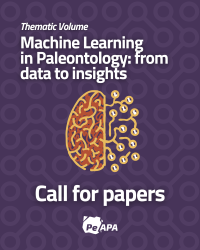A NEW PALEOCENE ARMADILLO (MAMMALIA, DASYPODOIDEA) FROM THE ITABORAÍ BASIN, BRAZIL
Abstract
Abstract. Riostegotherium yanei is a new genus and species described on the basis of isolated osteoderms from Itaboraí Basin (Brazil) of Itaboraian land-mammal age (middle Paleocene). The osteoderms of this armadillo have unique features distinguishing it from members of the early Tertiary Patagonian Astegotheriini. Among these are the presence of a subcircular main field, many pits in the grooves around this field, a better-developed central keel, and the absence of foramina on the posterior border. It is difficult to precise the affinities of the astegotheriines among the Dasypodoidea. Astegotheriines differ from other dasypodoids in having a moderate number of pits in the grooves limiting the main field, pelvic osteoderms with straight anterior and posterior borders, smooth lateral borders (indicating little articulation between osteoderms), and reduced number of piliferous foramina. The occurrence of at least two families of dasypodoids in the Itaboraian of Brazil, together with the presence of Peltephilidae and Astegotheriini in the Riochican of Patagonia, suggests that cingulates (or xenarthrans) were present at least since the early Paleocene in South America.
KEY WORDS. Riostegotherium yanei. Xenarthra. Cingulata. Itaboraian land-mammal age. Itaboraí Basin. Brazil.
Resumen. UN NUEVO ARMADILLO (MAMMALIA, DASYPODOIDEA) PALEOCENO DE LA CUENCA DE ITABORAÍ, BRASIL. Riostegotherium yanei es un nuevo género y especie de armadillo de la cuenca de Itaboraí, de edad mamífero Itaboraiense (Paleoceno medio) propuesto sobre osteodermos aislados. Los mismos presentan rasgos singulares que los diferencian de los Astegotheriini del Terciario temprano de la Patagonia, entre ellos: figura principal subcircular con muchas perforaciones en el que la rodea, carena central más desarrollada y ausencia de perforaciones en el borde posterior. Es difícil precisar las afinidades de los Astegotheriini dentro de los Dasypodoidea. Los Astegotheriini difieren de otros dasypodoideos por la presencia de moderado número de perforaciones en el surco que rodea la figura principal, borde anterior y posterior de los osteodermos pélvicos recto, bordes laterales lisos (indicando poca articulación entre los osteodermos), y número reducido de forámenes pilíferos. La presencia de distintas familias (dos por lo menos) de dasypodoideos en el Itaboraiense de Brasil, conjuntamente con la presencia de peltefilinos y astegoterinos en el Riochiquense de Patagonia, sugiere una mayor antigüedad (Paleoceno temprano por lo menos) de los cingulados (o xenartros) en América del Sur.
PALABRAS CLAVE. Riostegotherium yanei. Xenarthra. Cingulata. Edad mamífero Itaboraiense. Cuenca de Itaboraí. Brazil.
Downloads
Published
Issue
Section
License
Authors retain copyright and grant the journal right of first publication with the work simultaneously licensed under a Atribución/Reconocimiento 4.0 Internacional that allows others to share the work with an acknowledgement of the work's authorship and initial publication in this journal.
















